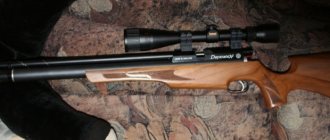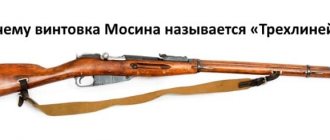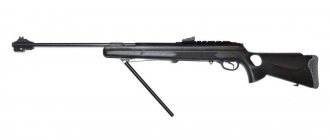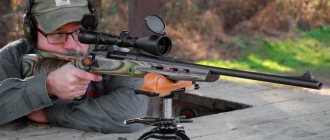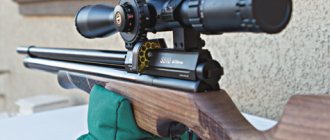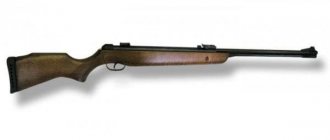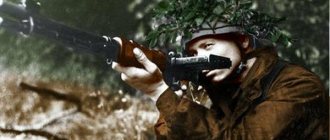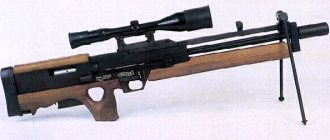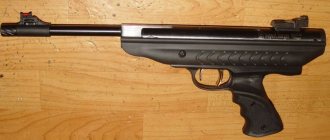The Hatsan 125 air rifle is the most popular spring-piston air rifle in our country. The high popularity of the Hatsan 125 rifle is explained by its high power, firing range, solid appearance and ease of shooting from it. The rifle can be used for training and recreational target shooting. The Hatsan 125 rifle is produced at a Turkish factory in Izmir. The Hatsan 125 rifle has one of the best price-quality ratios on the market.
Technical characteristics of Hatsan 125
- Caliber:
4.5 mm (.117) - Barrel type:
rifled - Number of grooves:
10 - Rifling direction:
right-handed - Operating principle:
spring-piston pneumatics - Cocking principle:
barrel fracture - Charge capacity:
single charge - Initial bullet speed:
380 m/s - Power:
7.5 J - Barrel length:
500 mm - Total length:
1205 mm - Weight:
3.65 kg
Technical characteristics and configuration features
To create the Hatsan 125, Turkish gunsmiths used high-quality materials and modern innovative technologies. The model belongs to the “magnum” class, is cocked by breaking the barrel and has the following technical base:
- single-shot;
- ammunition - lead bullets weighing about 0.5 g each;
- bullet speed - 380 meters per second;
- barrel diameter - 4.5 mm;
- trunk length - 1.25 m;
- distance from the butt plate shock absorber to the trigger - 380 mm;
- the stock is made of synthetic materials;
- Two-position fuse, automatic and manual.
Weighing no more than 3.7 kg, the stock with a carefully designed comfortable shape by engineers makes this rifle as maneuverable as a hunting rifle.
The high muzzle velocity allows this rifle to be used for shooting at moving targets. Hunting roe deer with the Hatsan 125 will be possible, as with a conventional hunting rifle, with the proper experience and skills.
Design
The Hatsan 125 air rifle is a spring-piston, single-shot air rifle.
The Hatsan 125 rifle is equipped with a 500 mm long steel rifled barrel with 10 right-hand rifling. The rifle barrel caliber is most often 4.5 mm, although the manufacturer produces rifles in other calibers. Due to the length of the barrel, the balance of the rifle is shifted towards the barrel, which can be corrected by the rifle owner by weighting the stock. A plastic muzzle is installed at the end of the barrel, which makes cocking the rifle easier.
The energy source of the Hatsan 125 rifle is a mechanical spring. The rifle comes with two springs: one less powerful one is installed on the rifle so that the power of the rifle is within 7.5 Joules, the second more powerful one is included in the kit. Most owners of the Hatsan 125 rifle immediately after purchase install a more powerful spring, which provides an initial bullet speed of 380 m/s. Mechanical springs of air rifles have one serious drawback: they shrink quickly, so some owners replace them with gas springs. Inside the gas spring there is gas, which is compressed by the piston. Gas springs have a long service life, but are very sensitive to negative temperatures. It is not recommended to shoot at temperatures below -10 degrees; gas spring seals may fail.
The Hatsan 125 rifle is equipped with a Quattro Trigger trigger mechanism, which is a unique development of Hatsan and has been installed on their air rifles for more than 30 years.
The Hatsan 125 rifle is equipped with an automatic safety; when cocking the rifle, it automatically switches to a safe mode in which firing a shot is impossible. The red icon indicates that the rifle is in the firing position and is ready to fire.
The butt of the Hatsan 125 rifle is made of high-strength, high-hardness plastic. The color of the butt can be several options: dark, wood and camouflage. Sometimes you can find Hatsan 125 rifles from early years of production and limited editions whose buttstock is made of Turkish walnut. The length of the stock is adjusted using removable elastic pads of the TRIOPAD system. Additional inserts and a shock-absorbing butt pad significantly reduce recoil and make shooting more comfortable.
The Hatsan 125 rifle is equipped with open sights: a front sight made of fiber-optic thread with a diameter of 1.5 mm and a rear sight with fiber-optic threads in the form of a TruGlo bar. Using micrometric screws, the position of the aiming bar is adjusted horizontally and vertically. Fiber-optic threads are painted in contrasting colors. The rear sight is green, the front sight is red. Contrasting colors of the sight allow you to shoot in low light conditions.
The receiver of the rifle has milled grooves for installing an optical sight. When choosing an optical sight for the Hatsan 125 rifle, you should keep in mind that it, like many other spring-piston air rifles, has strong recoil. Hatsan tried to reduce the recoil of the rifle with a vibration compensation system (SAS), as well as through the pads and butt plate.
It is better to choose an optical sight with a constant magnification, designed for installation on spring-piston rifles, capable of withstanding their strong recoil. The optical sight should only be installed on a monoblock bracket that must have a stopper.
Separately about MTs-21-12
photo: Mikhail Semin
The feeling of some excessive harshness and categoricalness in my conclusions about this gun never left me. For many years, I scrupulously listened to the opinions of other hunters about MC, looked for materials and reviews from people authoritative in hunting in magazines.
Apparently, there was no confidence in the correctness of his categorical statement: “Browning” is yes, but MTs-21 is no. Well, the hunt - real, real - put everything in its place and quite accurately, I think.
It so happened that throughout the last season I only took the MTs-21 hunting. He himself stood up for the classics, for the horizontal double-barreled gun. And on you: like a young man - a semi-automatic. What's the matter? There were several reasons, quite serious after long off-season reflections.
Age-related weakening of vision, especially in the right, dominant eye. Psychological uncertainty in shooting due to incomplete stock (slightly less than the required retraction and loss of the IZH-54 stock, my main double-barreled gun. For broad shoulders, of course, it is better to have a custom stock made by a good craftsman). By the way. Konstantinov is wrong.
IZH-54 is not a “so-so” gun. This is clearly an above average rifle. Quality workmanship (for metal, wood, fit of parts) is the essence of IZH-54. Where can one compare with the IZH-43 - all that remains of the horizontal planes at the moment for the ordinary hunter in Russia.
And finally, five shots - I really wanted to get the hare; It’s not easy to do this alone, much less guaranteed. Got it! Twelve Russians. A pack of cartridges was enough. Not a single empty exit. Not a single thing was missed. Fantastic! This season is MC’s swan song.
Everything is simple and natural. Appropriateness! My MC for me is perfect. The butt was being completed. I shortened it a little, with a change in pitch. In the end (it seems like I put my hands on it a little): even if you throw it up unconscious, it will land as it should. One can also say the eternal truth: adaptability is what makes great shooting. And it already has a good cartridge and a good barrel. I feel this, I know and I am 100% sure.
Several years of neglecting the machine from wild irritation at rare but constant failures of the machine and, as a rule, on “easy” hares. The MTs-21 is undoubtedly a “bunny” gun. What's the matter? I studied the mechanism for a long time - I figured it out! Stopping the barrel in the rear position (the most common delay) does not count. Everything is very clear here - an uncalibrated cartridge.
Sometimes I did not reach the end of the bolt with a new cartridge from the magazine. The empty cartridge case is ejected, the cartridge is fed correctly from the magazine from the tray, the barrel goes out, the bolt moves and stops in the middle. So far I have guessed: the bolt wedge pops out early and rests against the barrel shank. I thought for a long time, why is this?
Others did not note such a delay.
In hunting periodicals, they quite often examine (“magnum” - until “death”, not justified, in my opinion) the reasons for failures of the MTs-21, with sometimes useful advice on small things. But if you look at it, it’s clear: bad cartridge, clogging of the mechanism, defective cartridge, gross defective metal work. I was "lucky".
| photo: Mikhail Semin |
The shutter of my MC initially had a surprise, and with a decent load the “surprise” began to get annoying. The bottom line. In the bolt, the left pusher (15th position on the gun diagram in the passport) and the right pusher (16th position) are connected (on a pin) to the breaker (14th position).
The breaker is a hardened, spring-loaded, S-shaped, massive (along the gate) part. There is an angle at the junction with the pushers. The pushers go into the butt. When the bolt is returned to its place, the pushers at a certain moment (the angle is this moment) act on the breaker and the stop (8th position in the diagram) goes up into the hole in the barrel shank. The angle is not right - the stop pops out early, and the bolt rests against the barrel in the middle of the return.
In my MC, apparently, the tolerances in fitting these bolt parts were, to put it mildly, “uncultured” technologically, plus the gun works decently - this is the result: a most interesting gun, very decent in combat, but there is no faith in it. Faith in the gun is 100% of the hunt. This is the maximum possible in shooting. In general, I didn’t immediately figure out the problem with the bolt of my MC (others may have a different “culture” of gun assembly), it took a couple of years, but I figured it out. What did you do? I found a tool maker.
And by touch, for the third time, we made a new breaker and two pushers. Found the angle of articulation; the connection of the pushers with the breaker was made without backlash. Great master, one year, a couple of hundred rounds. The result is a “Swiss” watch, not an MC shutter.
With a good cartridge (for the MTs-21 this is the law), my machine gun does not delay. You can already pray for him! The hunting results are fantastic. In fact, my whole life with this gun. Favorite gun. Prayed. Not a piece of hardware without a soul from a store. And beautiful. Very. You can feel the power when you look at it. It would also benefit from finishing at a modern level.
As the apotheosis of my hunting career, I planned to give myself an anniversary, prestigious gift - a Beretta AL-391. No need. Now there is no need. I have a machine gun. Reliable. It's all in the machine. And Beretta is unlikely to withstand my hunts. I am not a “parquet” hunter. MC – it will endure, I know. A very durable, strong gun. Thirty years of operation is not an opinion out of nowhere. I will satisfy my love for weapons (hunting) with the MP-153. I want to know what Russian gunsmiths can do. I really hope they can. Two or three years, I’ll be alive, there will be – “separately about the MP-153.”
| photo: Mikhail Semin |
Lastly. With high-quality assembly and finishing, the MTs-21 is a very serious hunting rifle. Let's hope. It does not like amateurs or novice hunters. Requires health from the hunter. The gun is a bit heavy. The balance is not perfect. But with strong hands, constant training, good application, shooting “goes”. Shooting is desirable - “meaningful”, that is, shooting in “bursts” - the result is funny. Five shots - professional. Shooting at random is the stupidity of an amateur.
The hare is the main “hero-lover” of MTs-21. The heavy trunk does not like to look at the sky: a duck is not the right thing for MC. The cartridge is only powerful. For 36 g 42 grams - no need. Extra. Shot No. 1 and No. 3 – the ideal choke is 1 mm. My “Clover” with 36g shot No. 1 went great. No moonshine cartridge can compare. The 1 mm choke on the MC barrel suits me very well. I don’t like “loose” guns. “Close” shooting is rare. “Far” is valuable, especially for the brown hare. There is no faith in attachments. The MC barrel is what you need. 750 mm – possible.
And the barrel is good. 30 years. Chrome is in place. The coating is live, black. The chamber is moderately “strict”. Fine. The fight is sharp; accuracy is just right for me and the hare.
Don't be foolish with the buffer system. The main thing is a powerful cartridge: the barrel will work back and forth. Strong and stable, cone washers are nonsense. Lubrication – clean, moderate. I had no problems with lubrication in either hot or cold weather. Just a little and everything is fine.
And still. Main. Appropriateness. The tree in MC-21 is terribly primitive. Cleverly, for “professionals” - a custom-made, fitted stock. Heavy, with a heavy rubber butt pad. The gun is heavier. Balance is better. I know it from myself and have tested it.
The main thing is training. MTs-21 once a year when hunting - the result is funny. The main, favorite gun in constant, frequent, favorite hunts (hare - dear) and shooting, close to absolute. This season, on the last day, on the twelfth rusak, I was already thinking: where have I gotten to? Straight up - a killer hare. But, thank God, luck in hunting does not last forever. I will still grieve, looking at the departed “faithful” hare.
Gentlemen gunsmiths! God forbid, remove the MTs-21 from production. Everything can be expected from you. After all, we waited for the trigger IZH-43. Nikolaev semi-automatic (this is no longer a Browning, maybe better) is a Russian classic. Alive. Unlike the dead IZH-54, TOZ-BM. We need to make it better, at a modern technological level, even if it’s more expensive, even so. “Chinese” in hunting weapons is unacceptable. And the Chinese are moving away from “Chineseness” - smartly. Russian weapons must begin to evolve towards high production technology.
| photo: Mikhail Semin |
I am very happy. I didn’t expect that after many years of hunting, I would already get such hunting pleasure. Received! From MC-21! No wonder I had my eye on him in a hunting store in 1973. In the morning I wake up, look at it lovingly, hanging on the carpet next to the IZH-54, Sauer, IZH-59, TOZ-34, IZH-43, and I want to go hunting, with the MTs-21. I'm looking forward to the season. Joyfully. There is no doubt - I have a decent gun, and my little fellow is with it: by diligence and experience, and not by chance.
Hello and good hunting to comrades in passion, one of the few that a person has.
Sergey Iordanov August 23, 2013 at 11:00 pm
Hatsan 125 modifications
The Hatsan company produces the Hatsan 125 rifle in several modifications:
- Hatsan 125
rifle a standard modification that has a black stock made of impact-resistant plastic, a universal combo rail for installing an 11 mm dovetail + Weaver / Picatinny 22 mm optical sight. - Hatsan 125E
rifle a modification of the rifle, with a black plastic butt and a bar for mounting a dovetail optical sight. - The Hatsan 125 TH rifle
is a modification of the rifle that has a stock with a pistol grip with a cutout in the butt for winding the finger. The power of the Hatsan 125 TH rifle is 32 Joules. Rifle length 1205 mm. Rifle weight 4.1 kg. - The Hatsan 125 Vortex rifle
is a modification of the rifle equipped with a refillable Vortex gas spring. At the factory, the spring is inflated to a minimum, but with the help of a filling fitting, the spring power can be increased, bringing the bullet's flight speed to 380 m/s. - The Hatsan 125 TH Vortex rifle
is a modification of the rifle, equipped with a refillable Vortex gas spring and a butt with a pistol grip with a cutout for the winding of the finger. - The Hatsan 125 Sniper rifle
is a modification of the rifle that has a built-in sound moderator (silencer) designed to reduce shot noise. The rifle buttstock has an adjustable cheekpiece and the package includes a plastic bipod. The Hatsan 125 Sniper rifle has a length of 1240 mm and weighs 4.1 kg. - The Hatsan 125 MW rifle is
a modification of the rifle with a stock made of Magic Wood walnut. - The Hatsan 125 TH MW rifle is
a modification of the rifle with a stock made of Magic Wood walnut with a pistol grip formed by a hole for the thumb. - The Hatsan 125 Camo rifle
is a modification of the rifle equipped with a camouflage-colored plastic stock. - The Hatsan 125 TH Camo rifle
is a modification of the rifle, equipped with a camouflage-colored plastic stock with a pistol grip in the form of a thumb hole.
Modifications
On the domestic arms market, the Hatsan 125 model is presented in six different versions, differing mainly in modification, color and stock material. The most common:
- Hatsan 125 MW. One of the best in its class. It is equipped with a TRUGLO sight, the contrasting fiber-optic threads of which make shooting from this model even more accurate and accurate. The rifled handle provides comfort while shooting.
- Hatsan125 TH. Pneumatic pistol grip. Comfortable only for right-handed people. The TRIOPAD system provides shock absorption from the shot, making the rifle more comfortable.
- Hatsan 125 Camo. It differs from other models mainly in the camouflage color of the butt and the plastic body of the rifle.
All models can be used for hunting some types of birds and small game. The most successful and experienced hunters go hunting with the Khatsan 125 for roe deer, wild boar and other animals.
Advantages
The Hatsan 125 rifle has become one of the most popular air rifles due to its advantages:
- High shot power
- a rifle with a mechanical spring is capable of delivering 29-32 Joules, a rifle with a gas spring is capable of delivering 32-36 Joules. - High initial bullet speed
- the rifle's bullet speed reaches 380 meters per second, which exceeds the speed of a bullet fired from a Makarov pistol (315 m/s). - Good accuracy of the rifle
- a rifle with a coil spring at a distance of 25 meters in a series of 5 shots provides a dispersion diameter of 3 mm, at a distance of 50 meters the dispersion diameter increases to 5 mm. - Good appearance of the rifle
- the rifle looks like a real weapon and not like a child's toy. - The ability to adjust the rifle to the shooter’s parameters
due to elastic inserts, and in the Sniper modification also due to the adjustable cheek piece. - Possibility of modernization
- by installing an optical sight and replacing the spring with a spring of higher power. - Optimal price-quality ratio.
Briefly about the characteristics of Hatsan 125
Standard spring-piston pneumatics, intended for hunting and sport shooting, are available in three versions: wood, plastic and camouflage. Each of the modifications is attractive in its own way, but the technical performance of shooting is the same, regardless of the material on the stock. The bullets for the Hatsan 125 air rifle have a caliber of 4.5 mm. The length of the steel rifled barrel is 510 mm, the total length of the weapon is 1255 mm.
The initial speed at which the bullet leaves the barrel is 380 m/s. The minimum power is 7.5 J. It is worth mentioning here that in Russia any online weapons store sells pneumatics with higher power only with permission. Therefore, after purchase, many users increase the firing force by replacing the spring.
Other features of the model include an automatic safety, an adjustable trigger, the presence of an aiming bar and front sight, as well as a mount for additional sighting devices.
Flaws
With all the advantages that the rifle has, it also has some disadvantages:
- Heavy Recoil - The rifle's large compressor and spring-piston operating principle result in fairly strong recoil, which often results in a strong and painful blow to the finger, as well as a "sniper injury", that is, a broken eyebrow of the rifle owner.
- The need for a high-quality optical sight that can withstand the strong recoil of a rifle. A rigid monoblock should be used to mount the sight; the optical sight must be able to withstand strong recoil.
- Heavy weight of the rifle - due to its heavy weight, the rifle is not well suited for recreational shooting for children and women.
- Breaking the barrel to cock and load a rifle requires a lot of physical effort.
- The mechanical coil spring shrinks after several hundred shots, so many rifle owners replace it with a gas spring.
- The large size of the rifle and the balance on the barrel reduce the maneuverability and usability of the rifle.
Hatsan 125. Why is this air rifle called "bucket hole" and "paddle"?
Not in vain, oh not in vain! The 125th Hatsan will give odds to any air rifle-breaker (SPP - spring-piston pneumatics in a scientific way). It has so much power that it easily competes with the most powerful SPP rifle in the world (4.5 mm caliber) - Gamo Hunter 1250 with a half-gram bullet speed of 1250 feet per second (hence the number 1250 in the name). Let's convert feet to meters (1 foot = 30.48 cm) and we get 380 m/s.
Let's look at the characteristics of Hatsan 125
Manufactured in Türkiye, HATSAN ARMS COMPANY; caliber, mm - 4.5; length, mm - 1255; weight, g - 3650; initial bullet speed 0.5 g, m/s. - up to 380; number of charges, pcs. - 1; pneumatic type - spring-piston; cocking type - by breaking the barrel; barrel type - rifled; barrel length, mm - 510; sighting devices - front sight, sighting bar; mounting of additional sighting devices - yes; possibility of installing third-party sighting devices - yes; release type - adjustable; fuse type - automatic.
As you can see, in terms of “power”, calculated by the weight and initial velocity of the bullet, the “Turk” is not at all inferior to the famous Gamo Hunter 1250, while being about two and a half times cheaper.
It is available in three modifications: wood, plastic and... camouflage. The most attractive modification of the Hatsan 125 TH with a Monte Carlo stock, checkered pistol grip and thumb cutout. For those who shoot with the right hand, the model is very convenient. And the modification of the Hatsan 125 MW in wood is simply beautiful: the stock made of Turkish walnut is called “Magic Wood”.
The rifle's power is enough to shoot down game birds at a distance of up to 150 m! At the same time, it is simply impossible to hit a bird with a rifle at such a distance. When fired, the rifle moves sharply forward, then back, and even jumps up and down. We can only talk about any accuracy of the shot at a distance of up to 50 m.
Because of its peculiar recoil, the Hatsan 125 has another name: “optics killer.” I can confirm from my own experience: not the cheapest 100 dollar scope stopped adjusting after 200 shots with a normal iron spring. I had to change the optics to a more expensive one and install a gas piston instead of an iron spring. I advise everyone to do the same: the comfort and accuracy of shooting have noticeably improved. Yes, and the “sniper injury” - an eyebrow broken by an optical sight (due to the strong recoil of the weapon) - I personally only saw in the owners of this rifle.
But you can make holes in buckets and metal fences made of corrugated sheets, and pierce 3-centimeter pine boards with a standard Turkish iron spring. It is included separately, since in Russia it is impossible to sell air guns without a license with a power higher than 7.5 Joules. In the original, not weakened, Hatsan there are 125 of these Joules, about thirty. So the sellers use a trick, order rifles weakened to 7.5 Joules from the factory and separately in the same box there is a normal, powerful spring. The Russian Federation Law “On Weapons” does not prohibit this.
Photo: Source
The secret to the rifle's incredible power is simple. And it is this “secret” that gives her a recognizable, “paddle-shaped” appearance. It's all about the huge volume of the pipe, where a piston, called a compressor, moves under the influence of a spring. In this “pipe” the air is compressed to the strength of iron and pushes the bullet with approximately the same force throughout the entire length of the barrel.
That’s why, if you insert a spring from a Hatsan 125 into another rifle with a small compressor volume, the shot will only resemble hitting a bullet with a hammer. In this case, the bullet receives only the initial impulse and it will have to literally push through the rifling in the barrel, spending almost all the energy received on this. The power of the shot drops significantly. The large volume of the compressor is both a plus and a minus. Plus - huge power. The downside is its large size, large mass, and strong recoil.
More advantages...
- The front sight and rear sight are made of fiberglass light-accumulating threads. The front sight is red, the rear sight is green. Very comfortably. In this case, the rear sight is adjusted by special marked gears both vertically and horizontally.
- The length of the butt is adjusted by special elastic inserts. The butt plate is also shock-absorbing.
- The length of the trigger is adjusted with a special screw. The descent is peculiar, you just need to get used to it.
- Security at a high level. The safety is turned on when the rifle is cocked, and without “turning it off” the shot will not fire.
- Well, the price of a shot is the price of a bullet. No additional costs or additional equipment.
Of the minuses...
It takes considerable effort to break a rifle. The rifle is suitable for plinking, i.e. recreational shooting... Not at all suitable. After about the twentieth fracture, my hands simply begin to tremble. Even the strongest shooters.
The weapon is not so much heavy as it is inconvenient. When hunting, you get very tired due to the “lack of grip” of the rifle.
“For running hunting, the Hatsan 125 is a bit heavy and inconvenient, the IZH-27 (a heavy double-barreled over-and-under shotgun) is a piece of fluff” (from the forum of Hatsan 125 owners).
A heavy and long barrel shifts the balance of the rifle forward. Consequently, when shooting, the rifle “nods” a lot. The most advanced users even out the balance by filling the hollow stock with lead shot. An already heavy weapon becomes even heavier. At the same time, carrying a rifle while hunting becomes even more inconvenient. "Paddle"…
After several hundred shots, the standard spring “sits” and the power of the shot drops. Another argument in favor of replacing a metal spring with a gas piston.
And yet, with all its shortcomings, the Hatsan 125 rifle has found its niche as an inexpensive, but very powerful rifle with low consumption per shot. What else do power lovers need? Never mind! Just think, it's inconvenient. Just think, not very accurate. But the buckets are full of holes! Through!
Tags: air gun, air rifle
Tuning and upgrading the rifle
To improve the quality of shooting, many owners of the Khatsan 125 rifle are upgrading it. In most cases, rifle tuning comes down to two main changes:
- Replacing a standard mechanical coil spring with a higher capacity spring? Or a gas spring.
- Installing the optical sight on the mount provided for it on the rifle.
We evaluate the pros and cons
Khatsan 125, the price of which is 12 thousand rubles, is equipped with a front sight made of fiberglass light-accumulating fiber. Elastic inserts allow you to adjust the length of the stock. The butt plate is shock-absorbing, which softens recoil. And, of course, the most important advantage of the model is its high safety.
The disadvantages include the great effort required to break the trunk. In addition, the long and heavy barrel shifts the balance forward. Another disadvantage that may be an argument in favor of replacing the standard spring with a gas one: after a hundred or two shots, the iron spring “sits down,” reducing the firing force.
Increasing rifle power by replacing the spring
Many rifle owners either immediately after purchase or after some time increase the power of the rifle by replacing the spring with a more powerful mechanical coil spring or gas spring.
The mechanical coil spring of the Hatsan 125 rifle begins to shrink after several hundred shots, and after 1000-1200 shots it becomes completely sluggish, the power of the rifle decreases, and the initial speed of the bullet decreases to 250 or even 200 meters per second. The best way to increase the power of a rifle is to install a gas spring.
A gas spring uses energy from gas compression. When the barrel breaks, the piston compresses the gas in the cylinder. During the shot, the gas in the cylinder presses on the piston, creating the energy of the shot. Installing a gas spring on a rifle increases the range of the shot, increases the speed of the bullet, reduces recoil and simplifies the process of cocking the rifle. Installing a gas spring on a rifle is not very difficult; it can be done either in a store that sells pneumatics or at home. Many owners of Hatsan 125 rifles, when replacing a mechanical spring with a gas one, not only change the spring itself, but also chamfer the muzzle of the barrel, change the cuff and o-rings, and polish the piston and cylinder.
Power working for destruction
What can Hatsan 125 air rifles do? At a minimum, shoot down feathered or small fluffy game from a distance. At the most, “kill” the optics. Using this model, it is easy to hit a bird from a distance of 50 meters or kill a hare from 30. At the same time, the high power of the shot causes the weapon to behave rather strangely. During shooting, the rifle moves forward, then backward, while jumping slightly in the vertical direction. This kind of recoil leads to the fact that cheap optics quickly become unusable, especially when shooting with an iron spring.
If you need a good air rifle for hunting, you will have to spend a little to upgrade it. To begin with, you should replace the iron spring with a gas one, and then please yourself and the rifle with high-quality optics. You will noticeably improve not only accuracy, but also shooting comfort.
Selection and installation of an optical sight
Most owners of the Hatsan 125 rifle install an optical sight on it. According to experienced pneumatic enthusiasts, a 4x32 optical sight for the Hatsan 125 rifle will be quite sufficient. The Hatsan 125 rifle has great power and strong recoil, so you only need to purchase a high-quality scope that can withstand such recoil. The optical sight should be installed on a monoblock bracket.
Depreservation
After purchasing a rifle from a store, the owner of the rifle should re-open it. Most Hatsan 125 rifles are thickly coated with a special preservative grease, which must be removed before shooting. This can be done both in a weapons workshop and at home.
Preservative weapon grease should be removed from the outer surfaces of the rifle, and the grease should also be cleaned from the inner surface of the barrel. To clean the barrel, you should use a special airgun cleaning kit, which includes a plastic-braided cleaning rod. A steel cleaning rod should not be used to clean the barrel; it can flare the rifling on the breech side of the barrel, or flare the rifling on the muzzle side. All this will lead to a deterioration in the speed of the bullet and will worsen the accuracy of the rifle.
After this, you need to unscrew the stock fastenings and separate the barrel with the receiver and remove excess lubricant from all surfaces. The cylinder, trigger and cocking mechanism should not be disassembled unless necessary. If after a series of 10-20 shots you hear the rifle growling when firing and feel sticky grease when loading the rifle, you will have to disassemble the cylinder with the piston. The rifle is disassembled, the piston is removed, the piston and compressor are wiped with a dry cloth and a thin layer of gun oil or silicone grease is applied to them. The rifle is assembled and zeroed.
Shooting
Before firing a rifle, it must be properly sighted. It is best to zero in an air rifle indoors; if you do not have the opportunity to visit the shooting range, wait for clear and calm weather, since the flight of the bullet is influenced by environmental factors: temperature and humidity, precipitation, gusts of wind.
For zeroing, it is best to use a special zeroing machine, but if you don’t have one, you can use a vice, a flat horizontal surface, a bipod, or sandbags to fix the rifle.
For zeroing, use a regular sports round target with a black center. It is best to start zeroing the open sight of the Hatsan 125 rifle at a distance of 10 meters, gradually increasing the distance to 25-30 meters. The sighting of the optical sight mounted on the Hatsan 125 rifle begins immediately at a distance of 23-30 meters, then increasing to 40-45 meters.
Spring-piston rifles tend to reduce the power of the spring when firing in series, so you should pause between shots for 1-2 minutes, and after every five shots you need to take breaks of 15 minutes. Reload the rifle very carefully so as not to move the rifle. When zeroing the open sight of a Hatsan 125 rifle, it is recommended to use Diablo bullets weighing 0.68 grams; when zeroing an optical sight, you should increase the weight of the bullets to 1.02 grams.
The rifle is zeroed in series of 5 shots, the midpoint of impact is determined and the sight is adjusted. The sight is first sighted in the vertical plane, then in the horizontal. The rifle is zeroed until the difference between the aiming point and the impact point becomes minimal.
Two small things
PHOTO SHUTTERSTOCK
Unfortunately, our legislation considers a small-caliber rifle to be as dangerous as any rifled weapon, and requires five years of experience in owning a smooth-bore weapon to purchase one.
But if we approach the existing problem from the point of view of weapon ownership, then it would be most logical to give the right to purchase rifled weapons after five years of owning a small-caliber or pneumatic licensed weapon.
This issue has long been in need of change. But our legislators stubbornly hold on to “long-barreled hunting” weapons, nullifying the ownership of long-barreled self-defense weapons, LLCs and licensed pneumatics. But this is illogical!
If we are talking about experience of trouble-free ownership, then any weapon should be included in the list, and if we are talking about acquired skills, then only licensed pneumatics are suitable, since they are closest to rifled weapons. But there is little logic in our weapons law...
After all, following common sense, it should have been allowed to sell small things without five years of experience, and it was the experience with it that was considered pre-cut.
| The rifles, although very similar, have different bolt designs. Photo by the author. |
However, this is not what this article will talk about. Today I would like to talk about a small experiment that we conducted, comparing two very similar and at the same time fundamentally different small-caliber rifles.
I will say right away that you will not find any of them in stores, they are no longer produced, but nevertheless, the question that we posed to be resolved in the experiment is relevant and interesting.
The most common systems among small-caliber rifles are bolt-action rifles; they are simple, reliable and unpretentious. In our country, the biathlon shutter has become popular.
And this happened because Izhmash at one time was able to successfully adapt it for a hunting rifle. Since then, the straight-action shutter has taken root and still exists today. It was so popular that it replaced the rotary one. But the plant constantly received requests to make a classic shutter: they say it is more accurate, more reliable and more powerful when locking.
Here we need to make a small digression. The pressure that a small-caliber .22 LR cartridge develops is simply ridiculous when it comes to rifles. One of my friends said: “What is the pressure? The twenty-second can be fired from a tube from a telescopic antenna!”
This, of course, is an exaggeration (or understatement), but the truth is somewhere nearby. For rifles, either a regular 22 or a high-speed rifle of the same caliber, this is not a problem, so the lugs on the bolts are of little use; usually it all ends with one locking on the bolt handle.
By the way, I have not yet come across a single rifle with hardening (traces of high loads and wear) in this locking.
| PHOTO SVETLANA BURKOVSKAYA |
In general, the argument about reliable locking is more likely to be a marketing issue than a technical necessity.
But one way or another, Izhmash met the buyers halfway and made the SM2 KO rifle, very successful, very similar to the ancestor of the BI7 KO, but with a longitudinally sliding bolt. Comfortable stock, forged barrel, steel box - everything is reliable and of good quality. The designers added grooves in the butt, where two spare magazines were placed under the cover.
By the way, this is a very convenient option, just don’t forget that, according to the new law, you can’t transport equipped magazines there - thanks to the amendments. The accuracy turned out to be quite good, but there are no striking differences from biathlon.
The shutter did not provide any advantage in accuracy. However, the rifle was produced for several years and performed well.
| The main difference between carbines is the type of bolt. SM2 KO with a longitudinally sliding bolt; "Basic" with a biathlon shutter. Photo by the author. |
The search for the ideal rifle continued, new times brought new ideas, such features as the Weaver rail, the absence of open sights, etc. became fashionable.
Izhmash also responded to these calls by offering the “Basic” rifle, in which all the features of the SM2 KO are visible, only the bolt is old - a biathlon straight action. Practice has shown that a sliding bolt with rotary locking has no advantages, but we lose in reloading speed. So why the bolt then?
It was the comparison of these two rifles that became the goal of our experiment. The initial data is almost the same. In terms of their overall characteristics, the rifles are twin sisters, and they are similar in appearance.
But the existing differences make it possible to assess the degree of necessity of certain parameters.
Let's start with the trunks. On both rifles they are forged and quite thick for small guns. Both barrels are hanging out, that is, they do not touch the stock. The rifle is attached only in the area of the box. Very comfortable and identical in shape to the stock with the cheek.
The safeties are made differently: in SM2 KO it is a classic flag on the left of the box, in the usual place under the thumb, in BASIC it is a toggle flag in the trigger guard under the index finger. Which one is more convenient? And this is already a matter of habit.
Most hunters have more than one carbine, and there is a high probability that the second carbine will have a classic safety. Why then create entities? The magazines are identical and interchangeable.
| Photo by the author. |
Separately, I would like to talk about the steel box. On the SM2 KO there is a dovetail cut right into it; in BASIC, a separate part is riveted to it - the Weaver rail, which means there is a danger that when installing heavy sights, a play may appear between the rail and the box.
In general, when choosing, I would prefer a milled receiver rather than a riveted strip. It also seems like a mistake to avoid open sights, especially if you have the opportunity to shoot both carbines. They don't interfere with the optics, but leave more options.
Small bore rifles are often used for marksmanship training, in which case open sights are very useful. But sometimes you just want to shoot a rifle for fun without optics.
The only advantage of the longitudinally sliding shutter is the ability to remove it without removing the optics, but this is an old biathlon disease that has not yet been cured.
The fact is that optics are not needed in biathlon, and during development no one thought that the locking pin retracting upward could become a problem, but it only became so when owners began to install optics low on these rifles.
When shooting, both rifles behave well, are comfortable and have good accuracy of approximately 1.5 arc minutes.
| Both rifles provide trigger adjustment. Photo by the author. |
But let's return to the features of the shutter. Everything is very clear here: the biathlon shutter wins in almost everything. We did several series: we shot from a standing position and from a sitting position. In all positions, working with a straight biathlon bolt is easier and, importantly, faster.
In terms of time to completely empty a five-round magazine, adjusted for aiming, the biathlon bolt needs five seconds, and the bolt – seven. In addition, an interesting feature emerged: when the bolt is opened, the carbine tends to rotate around its axis; correcting this impulse requires effort, time, and leads to a shift in the line of sight.
In general, the biathlon shutter was a clear winner. But if you compare the carbines as they are, then the CM2 KO has its advantages. This includes the possibility of disassembly without removing the optics, the presence of open sights and a capacity for storing spare magazines.
It seems that Izhmash also came to the same conclusions, since both carbines were discontinued from mass production and were no longer produced. But they were replaced by the Sobol carbine, which combined the positive properties of these rifles and discarded unsuccessful experiments.
| Mounting optics on a milled dovetail looks preferable. Photo by the author. |
The described carbines can still be found on the secondary market, where they compete well with both domestic small-caliber rifles and imported carbines. Judge for yourself: what kind of carbine can you buy for 20 thousand rubles?
The rifles described in the article cost approximately the same, and in good condition. It should be taken into account that the barrels of small-caliber carbines practically do not wear out and you can find a sample in very good technical condition, even if it has a large shot.
So, given the price on the secondary market, these carbines, despite the shortcomings described, remain competitive and desirable for shooters.
The experiment showed that a bolt action cannot compete with a biathlon action in terms of reloading speed. But is the speed of this very reloading so important on a small-caliber carbine?
Whoever needs it will most likely bother buying a semi-automatic carbine; there are a lot of them in this caliber. The convenience of reloading is really interesting. In this case, the biathlon bolt turned out to be more comfortable and it was much more convenient to take the carbine out for the next shot. But, as always, this is all a matter of taste and practice.
Alexander Kudryashov December 21, 2022 at 07:46
Disassembly
Partial disassembly of the Hatsan 125 rifle is carried out for maintenance, lubrication and maintenance and repair work. To disassemble the rifle, perform the following steps:
- Unscrew the screws securing the stock to the rifle and separate the stock
- Unscrew the screw of the fuse axis
- Unscrew the screw of the trigger mechanism axis
- Disconnect the fuse spring
- Remove the sear axle
- Remove the backplate pin
- Remove the piston and spring
The rifle is assembled in the reverse order.
